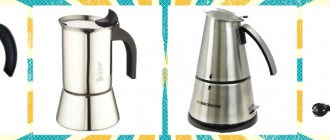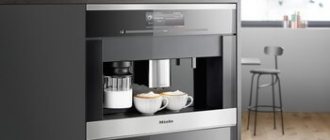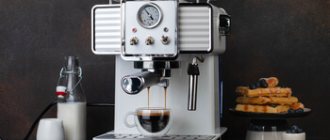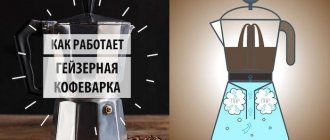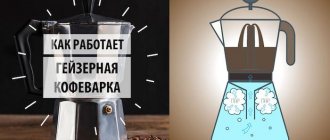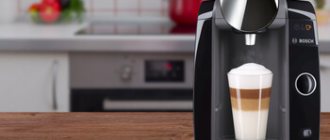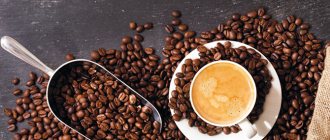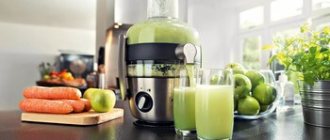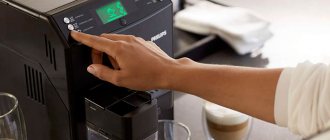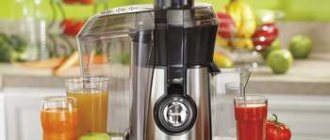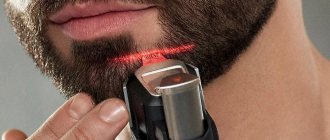The range of devices designed for making coffee is quite large. One such unit is a drip coffee maker. You can brew a fragrant, strong coffee drink in it. True, to achieve an ideal result, you should understand the principle of operation of this device, approach its choice responsibly and learn the intricacies of use.
Device structure
The device of the drip coffee maker is simple. Among its main elements:
- container for cold water. As a rule, it is placed in the back and cannot be removed;
- a boiler in which the liquid is heated directly;
- a heating element;
- a filter and funnel designed for crushed beans;
- reservoir for the prepared drink. It is a coffee pot or flask. In some models, this capacity is cups.
What are the features of drip coffee makers?
These devices have their pros and cons. These should be taken into account in order to use the drip coffee maker correctly.
Drip coffee maker device
Advantages:
- ease of operation;
- affordable price;
- compactness;
- brewing a lot of coffee at once;
- auto-heating
Flaws:
- the need to replace filtration elements,
- preparing exclusively classic coffee,
- lack of foam in the finished drink.
Principle of operation
The operating principle of a drip coffee maker is as follows:
- From the reservoir located at the rear, the liquid moves into the boiler.
- Once in the tank, the water heats up and then begins to rise up the tube.
- Through the crushed coffee beans, the liquid seeps drop by drop into the lower container.
- The drink is considered ready when all the water passes through the filter.
When using a drip coffee maker, coffee grounds do not fall into the cup. It remains in the filter.
The stand on which the finished drink is placed is often equipped with a heating function. Due to this, the coffee stays hot for a long time.
Scheme and description of work
Knowing how a drip coffee maker works, you can quickly get several servings of invigorating Americano at home. The cooking principle for different models is almost identical and follows the same scheme:
- From the water filling tank, liquid flows into the boiler.
- After heating, the water slowly flows up the tube.
- It then flows through the ground coffee.
- And it drips into the lower reservoir.
When all the heated water passes through the layer of coffee powder, the drink is ready. The grounds do not stain the mugs because they remain completely in the filter.
How to use a drip coffee maker correctly
It’s not for nothing that drip coffee makers are called the most reliable and simplest among coffee machines. Making coffee in them is incredibly easy. You only need to do a few steps:
- Connect the device to the network.
- Pour water into the container.
- Pour ground coffee beans into the filter at the rate of one teaspoon for every 100 ml of water.
- Press the power button.
- Wait until all the liquid seeps into the lower container.
- Turn off the unit.
- Pour the finished drink into a cup.
How to use: detailed instructions
Knowing how a drip coffee maker works, you can start preparing an invigorating drink. The process will not cause any difficulties; even a novice coffee lover can handle the preparation.
Instructions for using the drip coffee maker:
- Connect the machine to the network.
- Pour water into the tank up to the mark.
- Pour coffee into the filter. The proportions can be found in the instructions for the drip coffee maker. On average, 100 ml of water requires one and a half teaspoons of coffee or one large heap.
- Close the filter.
- Place a container for the finished drink.
- Start the coffee machine.
- Wait until the tank is filled with ready-made coffee.
- Turn off the coffee maker.
- Pour the drink into cups.
Once the coffee machine has cooled down, you can clean it. To do this, you need to remove the disposable filter or wash the reusable one.
Types of filters
There are two types of filters for drip coffee makers:
- disposable;
- reusable.
Reusable filters designed for drip coffee makers are included. They are a strainer-funnel. They are made from nylon or plastic. There are also products with spraying applied to nylon. Among the disadvantages of such filters is the need to clean them after each brewing of coffee.
Disposable products are usually made from cellulose. They come in two varieties:
- unprocessed. No bleaching agents are used in production, so they have a brown tint;
- bleached. In modern industry they are bleached with oxygen.
On sale you can find filters for coffee makers made from bamboo fibers.
The filter element along with the coffee grounds are simply thrown away after brewing is complete. There is no need to clean it. This is the main advantage of disposable options.
How does a drip coffee maker work?
This type of coffee maker is designed specifically for preparing Americano, so the principle of its operation is configured specifically for its production. To make the drink, you will need to pour in water and place freshly ground coffee in the filter for the drip coffee maker. After the device is turned on, the water will begin to heat up, then steam will form, which will transform into droplets of condensate. It is these drops that will fall into the filter with ground coffee and flow into a special flask. Once the procedure is completed, you can enjoy the aromatic drink.
A drip coffee maker is used quite widely, since it is not expensive, and it is quite easy to use.
If we look at the drip coffee maker in detail, it is worth noting that the device consists of a body with a container into which water should be poured and a flask, which has divisions indicating how many servings the delicacy will be ready. The flask comes into contact with a special heating platform, due to which water heating and coffee preparation begin.
Brew coffee in a drip coffee maker quickly and easily
In fact, the question of how to brew coffee in a drip coffee maker can be answered like this:
- Pour water into a special container;
- Place the required amount of ground grain into the filter. It is better if it is ground immediately before cooking, so that all the taste and aroma are preserved;
- The coffee maker closes and turns on.
In fact, after a while you will receive a fragrant delicacy and be able to enjoy it. If you are wondering what processes occur when preparing coffee in a drip coffee maker, then you should take an even closer look at the procedure. It is as follows:
- Water approaches the heater. It heats up to a high temperature and thus the water begins to turn into steam;
- The steam passes through special tubes and enters the upper compartment of the structure. Here it cools down a little and drops of condensation form;
- The drops then pass through a coffee filter;
- And they flow into a special container, from which the finished drink is then poured.
By the way, only ground coffee is always used for a drip coffee maker. One of the main differences between this device and a coffee machine is that this device cannot grind the grain itself, since it is not equipped with a coffee grinder. Therefore, you will either have to buy the ground product or grind the coffee beans in a special manual or electric coffee grinder.
It is not uncommon for a drip device to be also called a flow-through or filtration device, precisely due to its unique design and coffee filter.
The main difference between this type and other types of coffee makers is its operating principle due to the formation of condensate, which passes through a filter with ground grains. It is due to the process of preparing the delicacy that the device is called a drip device.
What is the difference between a drip coffee maker and a carob coffee maker? Everything is simple, with the same device. In a horn apparatus, the filter function is performed by the horn. Also, the principle of making coffee is different. In this type of device, coffee is prepared by applying strong water pressure through a brewer.
Some useful tips before making coffee
Before you start using a drip coffee maker, be sure to read the instructions. There are also a few important points to consider:
- use bottled water. In this case, it will be possible to avoid the appearance of scale;
- Store crushed grains in airtight containers. Thanks to this, it will be possible to preserve their original aroma;
- preheat the tank for the finished drink;
- Under no circumstances should you use damaged or broken filters. Such actions will lead to damage to the unit.
Pros and cons of a drip coffee maker
Those who started using a drip coffee maker managed to identify the advantages and disadvantages of the device.
Pros:
- easy to care for;
- most types of coffee are suitable;
- there are no complex mechanisms;
- compact design;
- the coffee is soft but rich;
- you can brew cocoa and brew tea;
- The drink is prepared quickly.
Minuses:
- It’s difficult to get strong coffee;
- there is the possibility of preparing only one type of drink - Americano;
- high product consumption;
- need to replace filters.
You can add cream or milk separately to the coffee, since the machine does not have the function of mixing and adding additional ingredients.
The most popular coffee recipes
Making coffee with a drip coffee maker is easy. In such a unit you can brew classic espresso, and use it to create even more sophisticated drinks.
Espresso
The list of products required for making espresso is minimal:
- 9 g ground coffee beans;
- 30 ml water.
The drink is prepared in a drip coffee maker according to the following principle:
- Coffee powder is poured into the filter.
- Water flows into the rear reservoir.
- The device turns on.
- When the liquid moves to the lower reservoir, the finished drink is poured into heated cups.
Latte
When making a latte you will need the following ingredients:
- 50 ml espresso;
- 200 ml milk;
- a pinch of cinnamon;
- 3 g chopped nuts.
Cooking steps:
- Brew espresso coffee in a coffee maker and pour it into a tall glass.
- Beat the milk with a blender or mixer.
- Pour the resulting mixture over the espresso.
- Place milk foam on top.
- Sprinkle the surface with nuts and cinnamon.
Viennese cappuccino
To make cappuccino you will need the following products:
- 50 ml of espresso prepared in a coffee maker;
- 50 ml whipped cream;
- 20 g chocolate.
Cappuccino coffee recipe:
- Heat the milk on the stove and pour into a glass.
- Slowly pour the finished espresso into the same container.
- Place whipped cream on top.
- Decorate the surface with chocolate chips.
Irish coffee drink
The original drink, popular in Ireland, contains the following components:
- 60 ml espresso;
- 20 g sugar;
- 20 ml water;
- 40 ml cream;
- 30 ml whiskey.
An Irish cocktail is prepared as follows:
- Brew espresso in a drip coffee machine.
- Mix water with sugar and bring to a boil.
- Pour the resulting syrup into coffee.
- Add whiskey to the composition.
- Spread whipped cream on the surface.
Drip coffee maker - what is it?
The drip coffee maker has a solid history. For the first time, a device that prepared coffee by straining hot water through ground powder was brought to the attention of the public back in 1800. The inventor of the method is a church minister, Parisian Archbishop Jean-Baptiste de Bellois. The invention was modernized, redesigned, and patented many times in different countries. But the principle remained the same. With the evolution of electrical appliances, the drip coffee maker acquired its own heating source and acquired the appearance we are familiar with.
Today's drip machine is an electric device with a heater in which hot water passes through a filter containing ground coffee and enters a reservoir. The strength and aroma of the drink is achieved through the slow passage of water through the coffee, during which it is enriched with the taste and aroma of the ground beans.
Top best drip coffee makers
To choose a good coffee maker for your home, you need to study the rating of the best models. The review presents their main characteristics. The TOP included the following devices:
- Redmond SkyCoffee RCM-1508S . Allows you to prepare aromatic, rich coffee. Equipped with a reusable filter. Electronic control. You can start the device from a smartphone.
- Maxwell MW-1650. Convenient, easy to use and reliable. The functionality is limited, but it is sufficient for use at home.
- Bosch TKA 3A031 . Considered one of the best drip coffee makers. It is reliable and easy to use;
- Redmond RCM-1510 . The model is durable, high quality, equipped with a delay timer. The kit includes a reusable metallized filter.
- Philips Daily Mini . Features a stylish design. Characterized by increased strength and reliability.
- Philips HD7459 . The build quality is at a high level. It is possible to delay the start. The only drawback is the high price.
Redmond SkyCoffee RCM-1508S
Maxwell MW-1650
Bosch TKA 3A031
Redmond RCM-1510
Philips HD7459
Philips Daily Mini
Peculiarities
What else do those who are interested in how to use a drip coffee maker need to know? The device prepares only one type of coffee – natural black filtered. This drink is called Americano because it is what is offered in coffee shops in the USA. With such a device you will not be able to prepare espresso, cappuccino, or oriental coffee.
The strength of the drink will be medium. Although it is possible to increase this indicator if you take finely ground coffee and a little water. Typically, the device uses beans that are medium to deep roasted and medium ground. In terms of simplicity and reliability, this coffee maker is a leader.
How to choose a drip coffee maker
The choice of a drip type of coffee maker should be made taking into account its functional features. The following points should be taken into account:
- Power. The brewing speed directly depends on it. Lovers of strong espresso should choose a unit with a power of no more than 800 W. If the priority is not strength, but speed of preparation, then these indicators should be higher.
- Volume. As a rule, the capacity of the water tank varies between 1-1.5 liters. Volumetric containers are purchased for offices. For home use, 1 liter is enough. It is not necessary to fill it out completely. Exactly as much liquid is poured in as is needed to prepare the drink.
- Flask . They are round, trapezoidal, and in the form of a thermos. The materials used to make them can be glass and plastic. It is recommended to give preference to glass options. The form is not of fundamental importance.
- Anti-drip system. This feature eliminates the need to wait until the rear reservoir is completely empty. At any time, you can pause the process, pour a portion of the drink and put the tank back in place to continue brewing.
- Overfill protection. The function involves stopping the filling process of the lower reservoir when it is completely filled.
- Automatic dosage . The device itself selects the optimal ratio of grains and water.
- Heating. A special stand ensures that the tank with the finished drink remains at a high temperature.
How to choose a drip coffee maker: we help you decide on the criteria
The traditional drip coffee maker is a familiar household appliance for both ordinary home users and office workers - after all, the drip coffee maker is most often purchased to brew coffee in the office.
Travel lovers will also remember that drip coffee can be purchased in many Scandinavian countries (for example, in Finland), and such coffee can be found not only in cafes and gas stations, but also in much more unexpected places. For example, a drip coffee maker can be found in the most ordinary second-hand store, so you can literally get a glass of coffee for reasonable money without leaving the fitting room.
The main complaint about drip coffee makers is also well known: the most common negative is usually formulated as “the coffee is not strong enough” or even more radically, “it’s not coffee, it’s some kind of mud.” Looking ahead a little, we will inform you that the “to blame” in this case may be both the quality of the device and the insufficient qualifications (or greed) of the barista, who did not pour enough coffee into the filter. Finally, let's not forget that in some countries they traditionally drink weak coffee, considering this a variant of the norm.
Classic drip coffee maker
So, let's figure out what types of drip coffee makers are available and how to choose the model that best suits your needs.
First, let's take a look at the basic physical characteristics of our device. These include parameters such as body material, power, volume of the flask (jug), etc.
Drip coffee maker device
A drip coffee maker is the simplest device among the entire family of coffee makers. coffee making equipment. It consists of a water heater (a stove is mounted on top of it to heat the coffee pot), a water tank and a compartment for storing coffee. Control is carried out using a fairly simple electromechanical board. Although there may be nuances here - you can find more advanced models, or you can find them equipped with a single on/off button.
Budget model Kitfort KT-715
Find out the price
When you turn on the device, water from the tank flows to the heater, where it turns into a mixture of hot water and steam and rises through the tube into the compartment with coffee. The remaining steam condenses, turning into hot water, which flows down and seeps through the coffee under natural pressure. After the water in the tank runs out, the heater continues to operate, thus switching to the mode of heating the finished drink.
What conclusions can we draw from this information?
The first (and most important) is that a drip coffee maker is designed to make one type of drink, which is called “filter coffee” or “real Americano”. You can immediately forget about words like “espresso”, “ristretto”, and even more so “cappuccino”. Even an ordinary geyser coffee maker will brew a much stronger drink than a drip coffee maker.
The second conclusion follows directly from the first: if you drink exclusively Americano, then there is no point in considering more expensive and more complex coffee makers (for example, carob). Brewing strong coffee and then diluting it with boiling water is not the best idea (including from a financial point of view).
Specifications
A drip coffee maker has several characteristics that it makes sense to pay attention to literally at the first glance at the model that interests you.
Housing material
Most drip coffee makers are frankly inexpensive devices, and therefore their body in most cases is made of food-grade plastic. More expensive models can be found in a plastic case hidden under metal sheets. Such coffee makers look more respectable, but the metal casing has no practical use: it in no way contributes to more adequate thermoregulation and does not affect the quality of the final drink.
Volume and structure of the water container
There are usually two requirements for a water container: it must be large enough to prepare the required amount of coffee at a time and it must be easy enough to clean. In practice, this means that the container must have a lid for adding water, and the container itself must be easily removed in order to wash it (which will inevitably have to be done from time to time). It’s a good idea if the container is in line of sight, which will allow you to visually monitor the level of remaining water.
Flask material and volume
The flask (jug) of drip coffee makers is usually made of glass. Its volume corresponds to the volume of the water container (a full container will allow you to prepare a full flask of coffee). There are usually marks on the flask (as well as on the water container) that allow you to measure the required amount of water in the cups (however, these marks do not always correspond to the standard volume of the cups). The jug is equipped with a spout and a plastic lid. It should be remembered that if the jug accidentally breaks, then in many cases this will mean the need to purchase a new coffee maker: due to the presence of a special anti-drip system, you most likely will not be able to use a jug from another model or another available container.
Standard jug for drip coffee maker
Filter material
The filter in drip coffee makers is used to ensure that ground coffee does not fall directly into the drink. Most devices are equipped with a reusable nylon (less commonly, “gold”) filter. The “gold” filter is in practice made of the same nylon, coated with a thin layer of titanium nitride: it is considered easier to clean and more durable.
The reusable filter will have to be cleaned of used coffee and washed after each use of the device.
Anti-drip system and nylon filter
An alternative to a reusable filter can be disposable paper filters. They come in different sizes and are marked with the numbers 1, 2, 4, 6, 8 and 12, which roughly correspond to the number of cups (servings of coffee). Most often you can find filters No. 2 and No. 4. “Two” is suitable for coffee makers with a volume of around 600-900 ml, “four” - from a liter and above.
Disposable paper filter
The disposable filter does not need to be washed: it can be carefully removed and thrown away along with the used coffee. Naturally, the filters are replaceable (if you wish, you can abandon the reusable filter and switch to disposable ones).
Heater power
Most drip coffee makers have a power of less than a kilowatt, which, however, is not a disadvantage: the device starts working after the heater reaches the required temperature, and the power required directly to heat the water is not so high. Although, of course, it will be more difficult to come across a high-power coffee maker that does not heat the water strongly enough than among low-power models.
Anti-drip system
Drip coffee makers are equipped with an anti-drip system that blocks the flow of drink when the jug is removed. This system is implemented using a special “faucet”, which is pressed by the lid of the jug. Of course, it will not be possible to completely avoid leaks: a few drops will inevitably fall on the heating platform.
Automatic shutdown
By design, drip coffee makers are designed in such a way that they spill the entire volume of water from the tank, after which they switch to the mode of heating the drink, which lasts on average about half an hour to an hour. So you will only have to be careful about the need to manually turn off the device if you do not want to use up all the water from the tank.
What if it’s more expensive?
More expensive drip coffee makers can provide a significantly increased range of options. The most interesting and useful of them are the functions of dosing a portion of water and the presence of a built-in coffee grinder. It's no secret that any coffee drink will turn out better if you use freshly ground beans to prepare it. Therefore, if you drink exclusively Americano, then the idea of combining a coffee grinder and coffee maker in one device and thus saving space on the kitchen table is quite logical.
Kitfort KT-716 with built-in coffee grinder
Find out the price
It’s especially nice that some models are equipped with real burr coffee grinders, which allow you to quite accurately adjust the degree of grinding of the grain. At the same time, the price of such devices may be relatively low (comparable to the price of a separate coffee grinder).
Philips HD7761 with burr grinder
Find out the price
There are also simpler knife coffee grinders, which, naturally, does not affect the quality of the finished drink for the better.
As for adjusting the volume of water, most of these devices will allow you to set the water flow “in cups” at the rate of 120-130 ml per cup.
The presence of such capabilities significantly improves the overall experience of using the device: ready-made coffee from beans can be obtained by pressing just a couple of buttons, and there is no need to ensure that exactly the amount of water in the tank is filled every time.
Less “smart” models may offer a delayed start function, thanks to which you can program the preparation of a drink at a specific time. It is clear that this function does not free you from other worries (grinding coffee, pouring the required amount of water, etc.).
Redmond SkyCoffee RCM-M1519S with control from a smartphone
Find out the price
conclusions
It would seem: if all drip coffee makers have similar functionality and brew approximately the same coffee, then what is the problem of choice? They poured the required amount of coffee, poured in the required amount of water, and got a drink. It turns out that not everything is so simple.
To begin with, let us mention that the cheapest models may be equipped with an unsuccessful water supply design, as a result of which some of the coffee in the filter does not fall under the water stream and simply does not brew. This problem is rare, but sometimes it still occurs. Frankly “Chinese” coffee makers can introduce the taste or smell of plastic. This problem also does not occur very often, and in some cases it can be eliminated by running the coffee maker “idle” several times.
But what often happens is an insufficient level of water heating, and it is not possible to predict this problem by the insufficient power of the coffee maker: this “disease” occurs both in not very powerful devices and in coffee makers with a power of about a kilowatt (which in theory should be more than sufficient). Some devices “cheat” by bringing the drink to the desired temperature already in the jug. It is clear that such delayed heating can no longer affect the taste of coffee.
Let us remind you that the temperature of the water at the moment of contact with the coffee should be 93 °C. The preparation time for the drink should be from 4 to 8 minutes. And if we can influence the time of spillage by increasing or decreasing the grinding of grain, then maintaining the temperature regime is beyond our competence.
It’s not for nothing that coffee kettles have a built-in thermometer
“Underheating” is especially noticeable when preparing small volumes of the drink (1-2 cups). This problem can be partially corrected by first pouring water (that is, warming up the coffee maker before starting to make coffee), but this requires additional time and repeated addition of water, which is ultimately considered inappropriate.
Alas, it is impossible to identify this problem without going directly to the operation of the coffee maker. Perhaps by turning to the reviews and comments of those who purchased the model of interest earlier. Alternatively, you can trust the brand in the hope that a big-name manufacturer will not release an outright bad device.
In conclusion, let us remind you that drip coffee makers best prepare coffee that corresponds to the “average” volume of the jug. According to the recommendations of the Specialty Coffee Association of America (SCAA), the ideal coffee in a drip coffee maker, according to these recommendations, will be obtained by using 90-120 g of coffee per 1.9 liters of water. This proportion is easier to remember if you calculate that the weight of water should be about 15 times the weight of coffee.
In practice, this means that many drip coffee makers are simply not capable of brewing the maximum portion. For example, a standard 1200 ml jug will require about 80 grams of coffee. It is clear that in practice this is unlikely to be realized: even if such an amount of coffee can be placed in a small filter, water will pass through it too slowly, which threatens to overflow the coffee grounds and clog the anti-drip system.
If you brew too small a portion, the coffee maker will not have time to warm up, which will lead to a deterioration in the quality of the drink (let’s not forget that even a good coffee maker will have a lower water temperature at the beginning of preparation than in the middle of the process).
Therefore, before choosing a drip coffee maker, you need to figure out what volume of coffee you are going to prepare most often and select the coffee maker so that the volume you choose corresponds to half the jug or ⅔ of its volume.
As for possible problems with insufficient water heating, it will not be possible to identify them by visual inspection or studying technical documentation. Deal with it.
What determines the taste of brewed coffee?
It is not always possible to brew espresso as tasty as we would like. This is due to the fact that the use of coffee makers has certain features. The taste of the prepared drink is influenced by several factors:
- water. You need to use clean, purified or bottled. The presence of impurities is unacceptable;
- grinding degree The finer the coffee fractions, the stronger the drink;
- dosage. The strength directly depends on the selected proportions of crushed grains and water;
- preheating the dishes. If the finished espresso is poured into a warm container, it fully reveals its taste and aroma qualities.
How to use a drip coffee maker
Drip coffee makers are preferred by those who like to do everything quickly and are not too worried that the taste of the prepared drink will not be the most exquisite.
Drip coffee makers do not require much effort to use and maintain.
Such coffee makers are electric and for the most part are considered budget household appliances. The most popular brands are Philips, Vitek, and Moulinex. The main advantage of this type of coffee maker is that you can forget about them during the preparation process. Even if the coffee is ready, nothing will happen to the coffee maker unless you turn it off immediately.
The process of making coffee in a drip coffee maker occurs as a liquid extraction, when hot water seeps through a layer of ground coffee and drips into a cup or a special flask with a handle. At the same time, the taste of the resulting drink is influenced by: the quality of the coffee itself and the degree of grinding, on which the speed of water passing through it depends.
If the water flows through too quickly, the coffee turns out weak and inexpressive, and when the flow is slower, the taste becomes more concentrated and even bitter.
To achieve the correct strength of the drink, separate filter models designed for coffee powder of different degrees of grinding help. The finer the grind, the richer the taste and the more noticeable the bitterness. If you prefer to use a drip coffee maker, then determine the proportions of water and coffee you like, the appropriate grind and strength of your favorite drink experimentally , and then simply stick to the recipe you received.
The strength and bitterness of the resulting drink largely depends on the fineness of grinding the coffee beans.
For brewing coffee, the optimal temperature is considered to be 90-95 ℃, but in many models of drip coffee makers you have to wait a long time for such hot water, due to which the drink turns out to be too bitter.
Before the brewing process, run the coffee maker with water in idle mode without adding coffee powder. Then pour the resulting hot water back into the tank and proceed directly to brewing coffee.
It is recommended not to leave brewed coffee on the heating element so that it does not acquire excess bitterness. In this regard, models of drip coffee makers are considered more preferable, in which the hot drink is poured not into a glass coffee pot or cup, but into a special thermos. These devices do not have separate heating elements in the lower stand.
How to clean a drip coffee maker? The conditions that allow you to successfully use a coffee maker include proper care - daily washing of the coffee pot and removable filters, monthly cleaning of the device. It is recommended to effectively clean the coffee maker using a solution of table vinegar (9%): pour the vinegar solution into a water container in a 1:1 ratio and turn on the coffee maker for a run. Then hot vinegar water is poured back in and another cycle of work is started. To remove residual dirt and vinegar, the final run is done with clean water.
We offer you to watch a video on the topic of using a drip coffee maker.
Pros and cons of units
Electric coffee makers of this type have both disadvantages and advantages. Among the positive aspects are:
- reliability;
- convenient control;
- large range of models;
- many budget options;
- It turns out to make a delicious drink.
Among the disadvantages of such devices:
- it is difficult to get a strong drink;
- high consumption of coffee powder;
- Possibility of preparing only Americano and espresso;
- the need to regularly replace or clean filters.
Drip machines designed for making coffee belong to the group of budget options. They are reliable and easy to use. The main thing is to choose them responsibly and use them in accordance with the instructions. At the same time, the device will last a long time, and the resulting drink will have excellent taste.
Drip coffee maker: how to use?
- To make coffee using a drip coffee maker, follow these steps.
- First, make sure that the device is connected to the power supply.
- Pour the required amount of water into the tank.
- Take a filter and pour ground coffee into it at the rate of one teaspoon per 100 milliliters of the finished drink. Then close the filter.
- Place the coffee container on the stand.
- Start the device by pressing the drink preparation button.
- After this, all that remains is to observe how the water gradually flows from the reservoir into the coffee pot, absorbing the components of the coffee beans.
- When this process is complete, turn off the coffee maker and pour the coffee into cups.
- If the filter is disposable, dispose of it with household waste.
- If you are using a reusable filter, shake out the coffee grounds, rinse thoroughly with water and dry in the open air.
You can see how to use a drip coffee maker in the following video:
